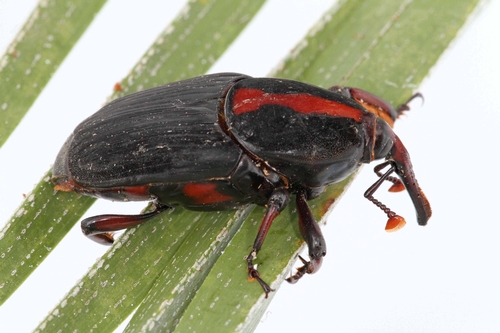
According to A.J. Kwamura, Secretary of the California Department of Food and Agriculture (CDFA) Secretary A.G. Kawamura. “It also endangers all of the decorative palms that are so common in our landscape and so much a part of the classic California backdrop. I would like to express my gratitude to the landscape contractor who originally reported this pest. He is a Good Samaritan who did the right thing when he took the time to notify local agricultural authorities, and he has given us a very valuable head-start in our efforts.”
Female red palm weevils bore into a palm tree to form a hole into which they lay eggs. Each female may lay an average of 250 eggs, which take about three days to hatch. Larvae emerge and tunnel toward the interior of the tree, inhibiting the tree’s ability to transport water and nutrients upward to the crown. After about two months of feeding, larvae pupate inside the tree for an average of three weeks before the reddish-brown adults emerge. Adults live for two to three months, during which time they feed on palms, mate multiple times and lay eggs.
Adult weevils are considered strong fliers, venturing more than a half-mile in search of host trees. With repeated flights over three to five days, weevils are reportedly capable of traveling nearly four-and-a-half miles from their hatch site. They are attracted to dying or damaged palms, but can also attack undamaged host trees. Symptoms of the weevil and the larval entry holes are often difficult to detect because the entry sites can be covered with offshoots and tree fibers. Careful inspection of infested palms may show holes in the crown or trunk, possibly along with oozing brown liquid and chewed fibers. In heavily infested trees, fallen pupal cases and dead adult weevils may be found around the base of the tree.
Residents are encouraged to report suspect infestations by calling the CDFA Pest Hotline at 1-800-491-1899.